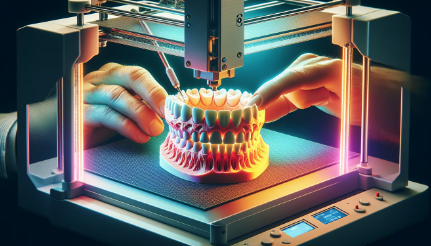Revolutionizing Smiles with Cutting-edge Technology
As the dental industry embraces cutting-edge technology, 3D printing emerges as a game-changer, transforming traditional practices with innovative solutions. From enhancing precision in dental restorations to revolutionizing orthodontics, 3D printing is reshaping oral healthcare. This post explores the latest breakthroughs in dental 3D printing technology and materials, offering insights into a future where personalization and efficiency redefine patient experiences.
A New Era of Dental Precision
3D printing is unlocking unprecedented levels of accuracy in dental applications. By leveraging advanced scanning technologies, dental professionals can create precise, custom-fit models for crowns, bridges, and implants. This precision improves the quality of dental work and significantly reduces the time required for procedures.
Key advantages include:
- Customization: Each dental appliance is tailored to the individual, ensuring a perfect fit and enhanced comfort.
- Speed: Traditional mold-based techniques are time-consuming, whereas 3D printing can produce results within hours.
- Reduced Waste: Additive manufacturing minimizes material waste, promoting sustainability in dental practices.
According to recent studies, 3D printing in dentistry enhances accuracy and optimizes workflow efficiency, providing a seamless experience for practitioners and patients.
Innovative Materials for Superior Outcomes
The evolution of 3D printing materials is a key driver in advancing dental technology. New composites and resins are being developed to enhance the functionality and durability of dental appliances. These materials provide improved aesthetics, strength, and biocompatibility, ensuring that dental solutions are effective and long-lasting.
Noteworthy material innovations include:
- Biocompatible Resins: Designed to integrate seamlessly with oral tissues, these resins reduce the risk of allergic reactions and increase patient comfort.
- Metal Alloys: New metal alloys are being developed for applications requiring high strength, such as dental implants, to offer exceptional durability.
- Full-Color Printing Materials: These allow for the creation of highly realistic dental prosthetics, enhancing the aesthetic appeal of restorations.
Organizations like 3D Systems are at the forefront of material innovation, continually exploring new composites to enhance the capabilities of dental 3D printing.
Reshaping Patient Experiences
Integrating 3D printing into dental practices is not just a leap in technological innovation but a transformative shift that enhances patient experiences in multiple ways. By streamlining workflows and optimizing precision, 3D printing enables dental professionals to provide faster, more efficient, and highly customized care.
One of the most significant advantages for patients is reduced chair time. Traditional dental procedures, such as creating crowns, bridges, dentures, and aligners, often require multiple appointments, messy impressions, and prolonged waiting periods for lab-fabricated restorations. With 3D printing, these processes are significantly accelerated. Dentists can now design, print, and fit restorations within a single visit, eliminating the inconvenience of temporary solutions and follow-up appointments.
Beyond speed, 3D printing also enhances accuracy. Digital impressions and computer-aided design (CAD) ensure that restorations and orthodontic appliances are precisely tailored to each patient’s unique dental anatomy. This precision minimizes the need for adjustments, improving comfort and functionality.
Moreover, the personalization afforded by 3D printing extends beyond aesthetics. While patients undoubtedly appreciate restorations that seamlessly match their natural teeth, the benefits impact oral health, bite alignment, and overall durability. Custom-fit dental implants, for example, provide a more secure and long-lasting solution, reducing the risk of complications and improving long-term oral health outcomes.
Additionally, 3D printing supports a more patient-centric approach to dentistry. With in-house printing capabilities, dentists can better involve patients in their treatment plans, visualizing proposed restorations and allowing for real-time modifications. This level of engagement fosters trust and reassurance, making patients feel more confident in their care.
Future Prospects
The future of dental 3D printing holds exciting potential, with ongoing research into bioprinting and the creation of living tissues. As technology advances, the possibilities for enhancing oral health and the quality of care are limitless.At Nota3D, we are committed to supporting the dental industry with state-of-the-art 3D printing solutions. Our expertise in leasing, purchasing, and repairing 3D printers enables dental professionals to harness the full potential of this transformative technology. As we continue to innovate, our focus remains on delivering speed, creativity, and responsiveness to meet the evolving needs of our clients.
